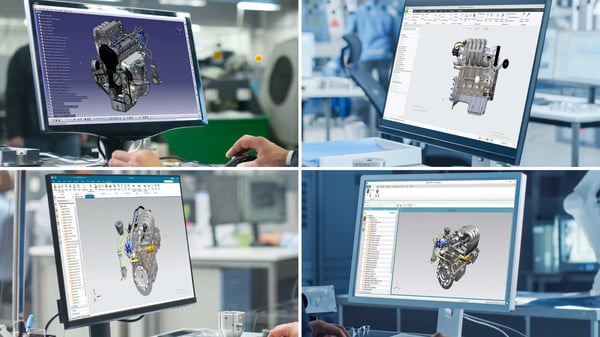Collaboration is important to consider for engineering and manufacturing companies. When it comes to product design and manufacture there are typically large supply chains, often spanning multiple countries. Unfortunately, not everyone in this supply chain will use the same CAD system, which makes collaborating on a single 3D design difficult.
However, direct database translators can be a solution to many of the issues that arise when trying to exchange CAD data. Direct translators allow users to convert data from one CAD format to another, within a multi-CAD supply chain, and to support downstream processes.
No Need to Purchase Additional CAD Licenses
One seemingly simple answer to the problem is to purchase CAD licenses of your partner’s software to access designs you have been sent. However, if you’re only using this software for data exchange it won’t be a cost-effective solution. Especially if you are part of a wider supply chain using many systems. On top of this, you will likely have to invest in additional training on these new CAD systems, which is time intensive. On the other hand, trying to convince other companies to adopt your CAD system is not always possible, since they will encounter the same issues.
Using a direct translator can solve these problems, allowing you and all your partners and suppliers to work in their preferred CAD system. With CAD translation, users can take CAD data provided by their partners or suppliers and convert it into the CAD format they need. Alternatively, data can be translated before sending it to the next stage in the manufacturing process. And since these translators are so simple to use very little training is required, saving valuable time, and allowing easy integration into current processes.
Save Time on Manual Data Processing
Another issue many find when working with multiple CAD formats is that manually processing data can be very time consuming. This is an issue that worsens the more data that needs to be processed. Solutions that require large amounts of manual involvement scale poorly and often can’t work as a long-term option.
With direct translators, the process of converting from one CAD system to another is automatic, requiring very little manual input. Batch processing is also an option for users with a large amount of data to process, providing a scalable solution to exchange data with partners and suppliers that use other CAD systems.
A Single Step Process for Accurate Outputs
When converting data there is the potential for data loss. However, the possibility of data degradation increases when there are more steps in the process. As a result, if a solution to the collaboration problem involves multiple steps it can not only be a lengthy process but there is also a bigger chance for an inaccurate output.
This isn’t a issue with a direct database translator as the single step conversion process produces highly accurate results. Since it is also very quick, these translators can provide a reliable and efficient way of sharing CAD data with a high degree of accuracy.
How CAD Translate Can Help
CAD Translate is backed up by over 30 years of experience of working with CAD data from experts in the field of CAD translation. By partnering with all the major CAD suppliers and utilizing vendor APIs, these translators deliver a seamless, robust, and accurate output in a single step process that is trusted by engineering and manufacturing companies globally.
Our direct database translators are an excellent option for users who need a non-parametric translation. Features and history aren’t supported; however, assembly structure, surfaces, colors, attribute data, and PMI/GT&T/FTA, are all brought through from the original CAD data using a Theorem translator. Since PMI/GT&T/FTA is supported, these translators can be integrated in workflows that use Model Based Definition (MBD). With a wide range of CAD and Visualization formats supported, Theorem’s direct database translators help to remove the issues associated with supply chain data exchange.
In Summary
There are many issues that can arise when exchanging data with users that use a different CAD system to you. Potential solutions can be expensive, time-consuming, or result in inaccurate outputs. However, direct database translators provide an option that is fast and reliable.
For more information about CAD data exchange, explore our CAD Translate products or get in touch with our team of CAD specialists today. You can also follow Theorem on LinkedIn for the latest news and insights.



